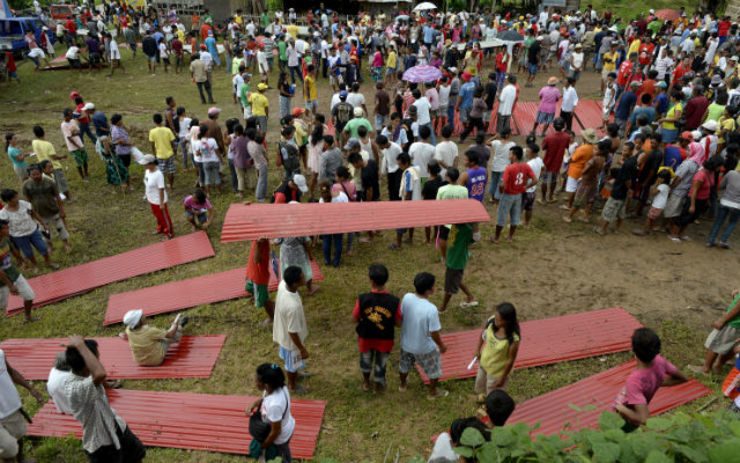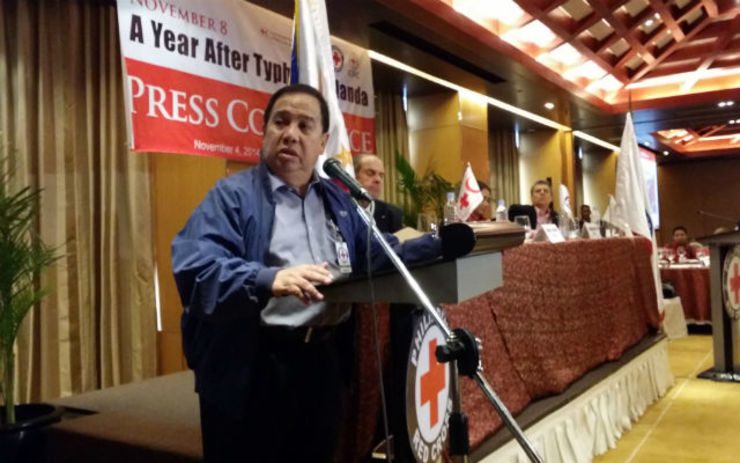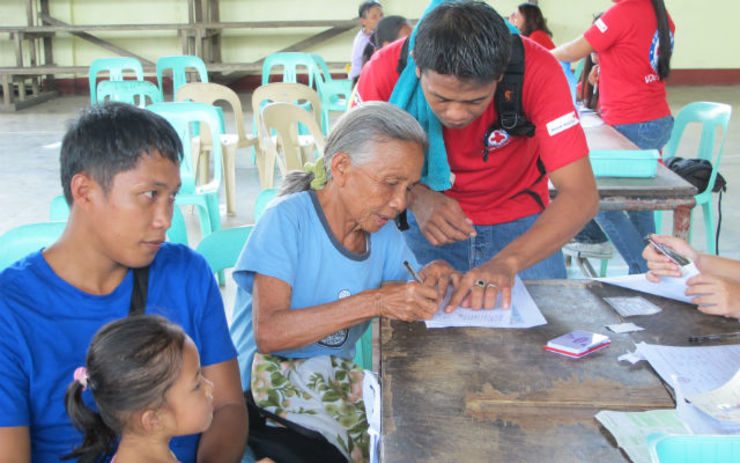SUMMARY
This is AI generated summarization, which may have errors. For context, always refer to the full article.

MANILA, Philippines – A logistical nightmare confronted personnel and volunteers of the Philippine Red Cross, the International Committee of the Red Cross (ICRC), and the International Federation of Red Cross and Red Crescent Societies (IFRC) after Super Typhoon Yolanda (Haiyan) ravaged the Visayas on November 8, 2013.
“Roads, airports, and seaports in the disaster zones were blocked by debris. Thousands were dead, and thousands more were missing. At that time, the challenge for us was how to get to the worst-hit areas,” said Gwendolyn Pang, PRC secretary general on Tuesday, November 4.
Almost a year after Yolanda, PRC, ICRC and IFRC commemorated the milestones of its response and rehabilitation operations in typhoon-ravaged areas, lauding its volunteers and personnel for their efforts in “making things happen.”
The super typhoon claimed at least 6,300 lives in the Visayas. Around 28,689 people were injured, and 16 million people were affected. Of this, 4.1 million Filipinos were displaced. (READ: Her name was Yolanda)
Thankfully, the Red Cross had personnel and volunteers on the ground who sent critical information to unaffected chapters.
“The initial emergency phase was traumatic since the proportion was so great. We didn’t know about other provinces that were hit. It was the volunteers on the ground who delivered the message of how Northern Cebu, Panay and Palawan were also ravaged,” PRC chairman Richard Gordon said on Tuesday.
Being prepared helped. Before the super typhoon hit, Gordon warned Red Cross chapters from Surigao to Samar that the typhoon would bring catastrophic results. Red Cross also prepositioned goods in areas expected to be hit by the typhoon.
“I told the volunteers to ensure their families’ safety. That’s always the first step so they can respond to others in need. When we got to the typhoon-hit areas, it was terrifying. We had to bring in chapters from across the country,” he added.
The first few weeks
During the first few weeks after Yolanda, Red Cross provided relief goods to survivors and held body retrieval operations. They then proceeded to help bring the survivors back to normalcy through constructing new shelters, giving cash grants, and bringing back livelihood to affected communities. (READ: Yolanda a year after: Only 2% of needed houses to be built by Nov 8)
As of October 10, 2014, the Red Cross organization had listed the following accomplishments:
- 6,081 homes built
- 13,506 households received cash or materials for shelter repair assistance
- 29,061 households received *USD 220 (PHP 9,658) for livelihood support
- 7 health facilities repaired/ built and equipped
- 128,000 people reached through hygiene promotion activities
- 14,300 people received psychosocial and emotional support
- 1,493 water systems repaired or constructed
- 192 classrooms repaired and equipped

Gordon said such achievements would not have been possible if not for the volunteers who helped.
“The numbers are very impressive, but the most impressive part are the volunteers who did all these. It was the volunteers who gathered the dead, conducted relief operations and assessment of the areas and survivors,” he added.
The PRC currently has 102 chapters nationwide with only 1,500 hired personnel. It has, however, an extensive reach of over 1 million volunteers.
Pang added: “Despite all the devastation, the Filipino heroism flourished. Help outpoured from people from all walks of life nationwide and from abroad…. No disaster can bring down the Filipino spirit.”
Some 8,000 Red Cross volunteers and personnel are still doing humanitarian work in Yolanda affected areas.
International support
The 3 organizations received a total of $386.6 million in support of Yolanda operations. Of this amount, 59% came from the general public; the rest, from 136 Red Cross and Red Crescent societies worldwide.
Forty-eight national societies also deployed personnel and assets to work hand in hand with the PRC.
With the vast amount of support coming in, Red Cross conducted assessments and audits of its expenses in Yolanda operations. Red Cross staff and volunteers worked with barangay recovery committees to validate the identities of beneficiary households. These village committees also exercised oversight functions during the organization’s relief and recovery efforts.
The following is the breakdown of Red Cross’ Yolanda operational costs:
- Shelter and community infrastructure – $38 million
- Food and livelihood – $36 million
- Water sanitation and hygiene promotion – $2.385 million
- Healthcare – $10 million
- Disaster risk reduction – $2.28 million
- Capacity building – $4.46 million
- Programme support and coordination – $14.9 million
IFRC Head of Delegation Marcel Fortier said the contributions show how the world was in solidarity with the Filipino people.
“Some societies have contributed thousands of dollars, while some gave millions. For us, it’s an act of solidarity. We have this principle that when a national society undergoes such catastrophe, all the members come and shoulder the crisis with them,” he said.
Fortier maintained that while the PRC received much aid in past crises, it’s not only a donee society. “The PRC is also deploying personnel and talents across the world. It recently sent a communication expert to Juba in South Sudan and a finance expert to West Africa for Ebola response.”
Lessons from Yolanda
Pang said the commemoration should serve as a reminder for Filipinos to build back better after Yolanda.
“It is sad that some people tend to remember their misfortunes but not Yolanda’s causes. It was not the heavy rains and strong winds that caused Yolanda’s floods, but people’s indifference to calls for disaster preparedness and mitigation,” she said. (READ: Yolanda survivors say sorry, pray for closure)
She added: “The ever daunting challenge remains – for us to ensure that the amount of countrywide preparation should be more than the strength of any super typhoon.”

The 3 organizations currently focus on kickstarting the livelihood of Yolanda-affected communities.
The initial cash grants of $220 to families were used by survivors to create income-generating activities, like farming, rearing livestock, and setting up local convenience shops.
Some 30,000 families have received support from the PRC as part of the organisation’s $360-million recovery plan for 500,000 families across Leyte, Samar, Cebu, Panay, and Palawan islands.
Pang challenged Red Cross staff and volunteers to continue the work they’re doing.
“The dreadful memories of last year’s disaster left us with indelible marks, particularly among families torn apart by the super typhoon. We must continue to be with them, assist these communities until they are able to get back to their feet,” she concluded. – Rappler.com
For Rappler’s full coverage of the 1st anniversary of Super Typhoon Yolanda (Haiyan), go to this page.
The Philippine Red Cross is a Project Agos partner.
*USD 1 = PHP 43.9
Add a comment
How does this make you feel?
There are no comments yet. Add your comment to start the conversation.